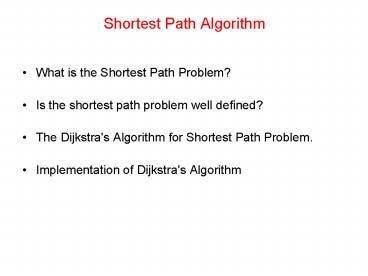Shortest Path Algorithm
1 / 13
Title: Shortest Path Algorithm
1
Shortest Path Algorithm
- What is the Shortest Path Problem?
- Is the shortest path problem well defined?
- The Dijkstra's Algorithm for Shortest Path
Problem. - Implementation of Dijkstra's Algorithm
2
What is the shortest path problem?
- In an edge-weighted graph, the weight of an edge
measures the cost of traveling that edge. - For example, in a graph representing a network of
airports, the weights could represent distance,
cost or time. - Such a graph could be used to answer any of the
following - What is the fastest way to get from A to B?
- Which route from A to B is the least expensive?
- What is the shortest possible distance from A to
B? - Each of these questions is an instance of the
same problem - The shortest path problem!
3
Is the shortest path problem well defined?
- If all the edges in a graph have non-negative
weights, then it is possible to find the shortest
path from any two vertices. - For example, in the figure below, the shortest
path from B to F is B, A, C, E, F with a
total cost of nine. - Thus, the problem is well defined for a graph
that contains non-negative weights.
4
Is the shortest path problem well defined? -
Cont'd
- Things get difficult for a graph with negative
weights. - For example, the path D, A, C, E, F costs 4 even
though the edge (D, A) costs 5 -- the longer the
less costly. - The problem gets even worse if the graph has a
negative cost cycle. e.g. D, A, C, D - A solution can be found even for negative-weight
graphs but not for graphs involving negative cost
cycles.
5
The Dijkstra's Algorithm
- Dijkstra's algorithm solves the single-source
shortest path problem for a non-negative weights
graph. - It finds the shortest path from an initial
vertex, say s, to all the other vertices.
6
The Dijkstra's Algorithm Cont'd
- // Let V be the set of all vertices in G, and s
the start vertex. - for(each vertex v)
- currentDistance(s-v) 8
- predecessor(v) undefined
- currentDistance(s-s) 0
- T V
- while(T ? ?)
- v a vertex in T with minimal currentDistance
from s - T T v
- for(each vertex u adjacent to v and in T)
- if(currentDistance(s-u) gt
currentDistance(s-v) weight(edge(vu)) - currentDistance(s-u)
currentDistance(s-v) weight(edge(vu)) - predecessor(u) v
For each vertex, the algorithm keeps track of its
current distance from the starting vertex and the
predecessor on the current path
7
Example
Tracing Dijkstras algorithm starting at vertex B
The resulting vertex-weighted graph is
8
Example
Tracing Dijkstras algorithm starting at vertex B
A
The resulting vertex-weighted graph is
3
B
C
D
0
4
6
8
9
E
F
9
Data structures required
- The implementation of Dijkstra's algorithm uses
the Entry structure, which contains the following
three fields - known a boolean variable indicating whether the
shortest path to v is known, initially false for
all vertices. - distance the shortest known distance from s to
v, initially infinity for all vertices except
that of s which is 0. - predecessor the predecessor of v on the path
from s to v, initially unknown for all vertices.
public class Algorithms static final class
Entry boolean known int
distance Vertex predecessor
Entry() known false
distance Integer.MAX_VALUE
predecessor null
10
Implementation of Dijkstra's Algorithm
- The dijkstrasAlgorithm method shown below takes
two arguments, a directed graph and the starting
vertex. - The method returns a vertex-weighted Digraph from
which the shortest path from s to any vertex can
be found. - Since in each pass, the vertex with the smallest
known distance is chosen, a minimum priority
queue is used to store the vertices.
public static Graph dijkstrasAlgorithm(Graph g,
Vertex start) int n g.getNumberOfVertices()
Entry table new Entryn for(int v
0 v lt n v) tablev new Entry()
tableg.getIndex(start).distance 0
PriorityQueue queue new BinaryHeap(
g.getNumberOfEdges())
queue.enqueue(new Association(new
Integer(0), start))
11
Implementation of Dijkstra's Algorithm - Cont'd
while(!queue.isEmpty()) Association
association (Association)queue.dequeueMin()
Vertex v1 (Vertex) association.getValue()
int n1 g.getIndex(v1)
if(!tablen1.known) tablen1.known
true Iterator p v1.getEmanatingEdges()
while (p.hasNext()) Edge
edge (Edge) p.next() Vertex v2
edge.getMate(v1) int n2
g.getIndex(v2) Integer weight
(Integer) edge.getWeight() int d
tablen1.distance weight.intValue()
if(tablen2.distance gt d)
tablen2.distance d
tablen2.predecessor v1
queue.enqueue(new Association(d, v2))
12
Implementation of Dijkstra's Algorithm Cont'd
Graph result new GraphAsLists(true)//Result
is Digraph Iterator it g.getVertices()
while (it.hasNext()) Vertex v (Vertex)
it.next() result.addVertex(v.getLabel(),
new Integer(tableg.getIndex(v).d
istance)) it
g.getVertices() while (it.hasNext())
Vertex v (Vertex) it.next() if (v !
start) String from v.getLabel()
String to tableg.getIndex(v).predecessor.g
etLabel() result.addEdge(from, to)
return result
13
Review Questions
- Use the graph Gc shown above to trace the
execution of Dijkstra's algorithm as it solves
the shortest path problem starting from vertex a. - Dijkstra's algorithm works as long as there are
no negative edge weights. Given a graph that
contains negative edge weights, we might be
tempted to eliminate the negative weights by
adding a constant weight to all of the edges.
Explain why this does not work. - Dijkstra's algorithm can be modified to deal with
negative edge weights (but not negative cost
cycles) by eliminating the known flag and by
inserting a vertex back into the queue every time
its tentative distance decreases. Implement
this modified algorithm.































